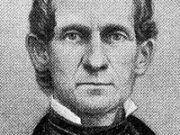Eugenius A. Nisbet served in the Georgia legislature, in the U.S. Congress, and as one of the original justices on the Supreme Court of Georgia. Nisbet was also an influential figure in both the secession movement and the Confederate government during the Civil War (1861-65).
Eugenius Aristides Nisbet was born in Greene County on December 7, 1803, to Penelope Cooper and James Nisbet. His father served in the General Assembly and was a framer of Georgia’s Constitution of 1798. The young Nisbet received his early education at Powelton Academy in Hancock County and went on to South Carolina College (later the University of South Carolina). Prior to his junior year he transferred to the University of Georgia, from which he would graduate first in his class in 1821. He obtained his legal education in the Athens office of Judge Augustin Smith Clayton, and then studied under the celebrated Judge James Gould at the Litchfield Law School in Connecticut. He was admitted to the bar at age twenty.
Nisbet began practicing law in Madison. In 1825 he wed Amanda Battle, and together they had twelve children. In 1827 he was elected to the state House of Representatives and remained there until 1830, when he was elected to the state senate. Nisbet remained in the senate for seven years, where he advocated the creation of a state supreme court.
A member of the Whig Party, Nisbet ran unsuccessfully for the U.S. House of Representatives in 1836 but was elected in two subsequent attempts. He served in Congress from 1839 to 1841, resigning on October 8, 1841, during his second term. The Macon Telegraph and Messenger, in its obituary honoring Nisbet on April 27, 1871, states that “on account of the condition of his private affairs and a growing distaste for political life, he resigned his seat” and “retired… with an unblemished character and enviable reputation.”
The Supreme Court of Georgia was created in 1845 and consisted of three justices elected by the legislature. Nisbet was elected, along with fellow Whig Joseph Henry Lumpkin and Democrat Hiram Warner. Despite having no judicial experience, Nisbet gained prominence while on the court due to his learned opinions. His time on the court lasted for only eight years; Henry L. Benning was elected to replace him in 1853 when the Democrats gained control of the legislature.
In 1861 Nisbet served as a delegate to the Georgia Secession Convention, where he introduced the resolution calling for disunion and for a committee of delegates to draft an Ordinance of Secession. Upon passage of the resolution, he was appointed to the committee. He introduced the committee report to the full convention and proposed the “unanimity of signature” rule, whereby, as a show of resolve, all convention delegates signed the ordinance regardless of their views on secession. Nisbet also served as a delegate to the Provisional Confederate Congress, which met in Montgomery, Alabama. He ran for governor in 1861 after secession, but was defeated by Joseph E. Brown.
After the election Nisbet resumed the practice of law in Macon. With a strong dedication to higher education, he also served on the boards of trustees for both the University of Georgia and Oglethorpe University in Atlanta. Nisbet died in Macon on March 18, 1871.




